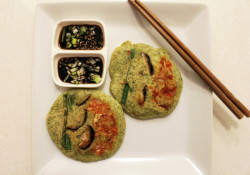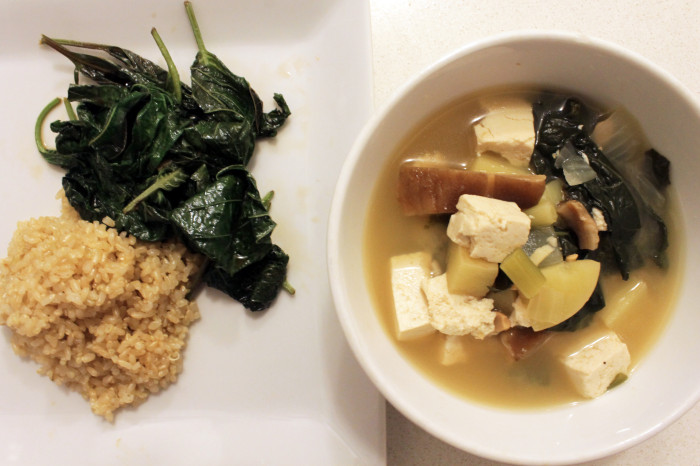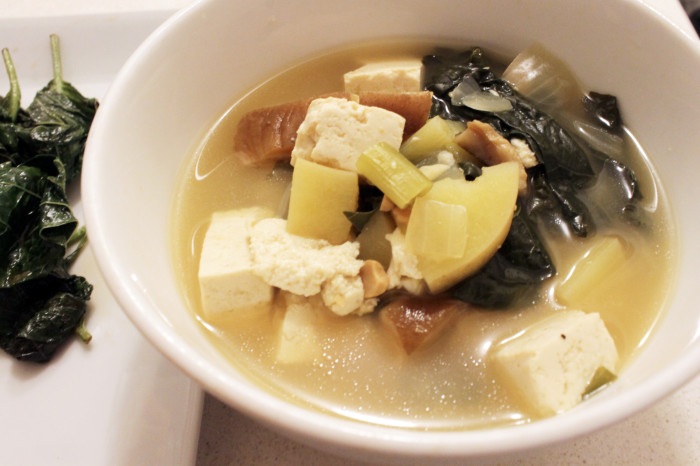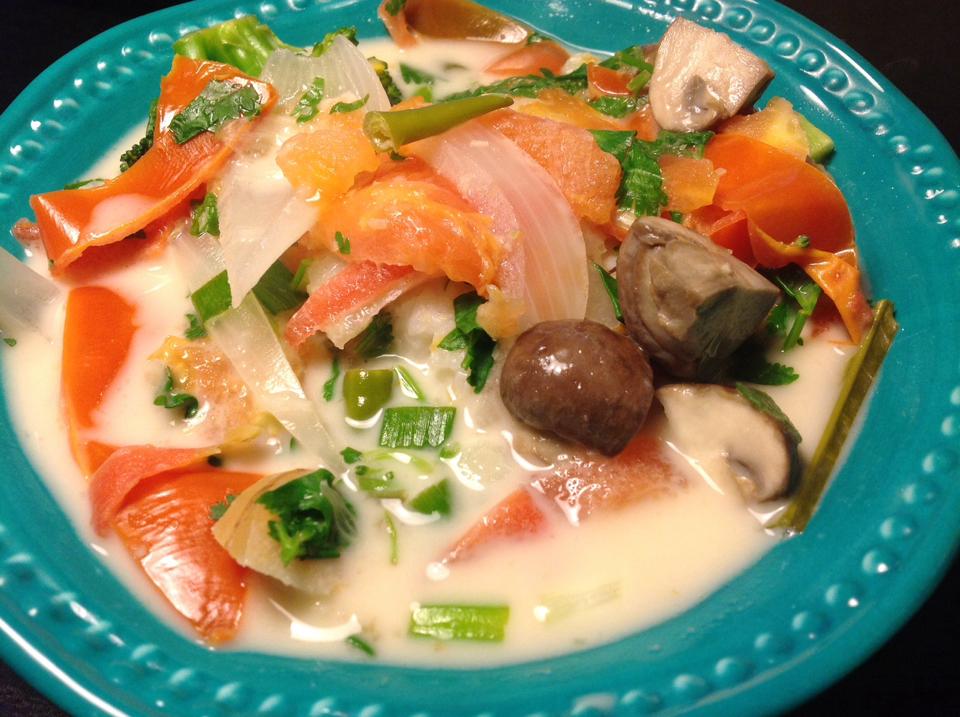
Vegan Korean food has a simplicity that belies its underlying elegance, like the way of arranging vegetables by their color and shape.
I know I did a Freedom Friday post recently on Korean mung bean pancakes, but this has been on my mind lately (meaning, I’ve been craving Korean food). Most Americans know Korean food from loud, smokey, barbecue restaurants with bulgogi and kalbi. And if they follow the foodie scene, they will have heard of celebrity chef David Chang, who built his Momofuku empire out of aggressively meat-centric nouveau Korean cuisine. (The menu to his restaurants used to claim, “We do not serve vegetarian-friendly items here.”) I find this reality frustrating because it was Korean food that made it so easy for me to become vegan overnight, about seven years ago.
Korea is a very mountainous country with thousands of years of agricultural history–and so, the cuisine reflects that heritage with rice at its center, and simply prepared mountain herbs, roots, and beans as accompaniments. For most of its history, tiny Korea was a farming country, not a ranching one; so they raised bulls and cows for plowing the field, never for milk and very seldom for food. Meat has become common in Korea only in the last thirty years or so; and while people once prized meat as a luxury at the beginning of the economic boom, there is an increasing awareness that eating less meat is healthier and better (basically, just like in the U.S.). Underneath the meaty layer, what I think of as “true” Korean cuisine has a much more elegant sensibility and even wit. Consider, for instance, the way of arranging vegetables by their different color and shapes, often on pancakes or bibimbap. Or the cheeky way of flavoring sesame leaves with sesame oil, and garnishing with sesame seeds (recipe below). It’s a very naturalist, but thoughtful way of cooking.
Vegetarian or vegan Korean food can be divided in two ways, though both are founded largely on rice, fresh vegetables, and herbs. First there is what can be thought of as “peasant food”–descended from what most Koreans would have eaten after a long hard day of plowing the field, this still forms the basis of home cooking. The foundation of almost every dish is some combination of garlic, scallions, sesame oil, sesame, soy sauce, gochu garu (red pepper flakes), and vinegar. There is always a bowl of rice at every meal, kimchi, usually one type of soup or stew, and namul, which can be any kind of raw or blanched herb or vegetable, dressed simply with the aforementioned ingredients. These might be anything from lotus root (simmered in soy sauce), young wild fern, burdock, Chinese chives, acorn jelly (made from boiled acorn), seaweed, mushrooms, radish, cabbage, etc. The protein would come from tofu, sprouted soy beans, sprouted mung beans, beans simmered in soy sauce, and whole grains. So simple, and so good for you.
Buddhist temple cuisine is the other category of vegan Korean food. Buddhists monks and nuns in Korea still prepare their meals the traditional way, by foraging in the mountains around the temple and making their own fermented sauces. Monks abstain from using any strong, spicy ingredients like garlic or red pepper flakes, which is thought to overstimulate and hinder meditation. They even make “white” kimchi without any red pepper flakes. Thankfully, frying is allowed, which makes for some delicious fried mushrooms and root vegetables. They guard their secret recipes for delicious namul and mock meat, which have been passed down from generation to generation. These temples draw a huge number of visitors, Buddhist and non-Buddhist, who can share a meal or even take cooking classes. In New York City, award-winning Hangawi and sister restaurant Francia are run by Korean Buddhists who base many of their dishes on temple cuisine.
Here are a few simple recipes for the “peasant” school of vegan Korean food. My boyfriend loved these mild, non spicy, yet fully flavored (and diet-friendly) dishes. They take less than 25 minutes to prepare from start to finish, so give it a try! It really will be worth it.
Vegan Doenjang Jjigae (Fermented soybean paste soup)
4 cups water
4 cloves garlic, smashed and chopped
2-3 stalks scallions
1/2 medium onion, chopped
about 6 dried shiitake mushrooms, soaked in water for at least 10 minutes until soft; reserve water (or fresh mushrooms)
1 medium potato, cleaned and diced
3 cups roughly chopped any kind of leafy dark green veggie (spinach is traditional, but I used hardier Tuscan kale here which works really well in the soup)
1/2 block tofu (I used firm, but feel free to use any texture)
5-6 tbsp doenjang (you can find this in a Korean market. If you have trouble finding it, just ask!)
1/4 tsp salt and pepper to taste
1. Boil water and add garlic, onion, potato. Chop up the reconstituted mushroom and add it to the pot, including the water. Fresh mushrooms will also work, but dried and reconstituted will have a bolder flavor.
2. When the water is boiling hard, add doenjang and stir well. Add the leafy greens, tofu, salt and pepper, and turn down the heat and simmer for about ten minutes.
3. Add the chopped scallions and turn up the heat to medium high, and get it boiling again for a few minutes before taking it off heat. And there you have the most hearty, pro-biotic, detoxifying, nutritious, oil-free and diet-friendly bowl of soup! Serve with rice. You can feel free to add some rice directly in the soup, or eat it on the side.
Sauteed Sesame Leaves
Wash sesame leaves well (I found a wee caterpillar in mine!). Start by sauteing some minced garlic in vegetable oil, then add the leaves and saute for a few minutes until the leaves are completely wilted. Add about 1 tbsp soy sauce and stir well. Just before taking off the heat, add just a tsp of sesame seed oil for flavor. Sprinkle with sesame seeds and serve with rice, of course.
More Asian recipes: Detox Dinner – Brown Rice Noodles with Shiitake and Edamame
Vegan Mandu (Korean Dumplings)
Pan Fried Tofu and Kimchi Sandwich
___
Photo: Peaceful Dumpling







